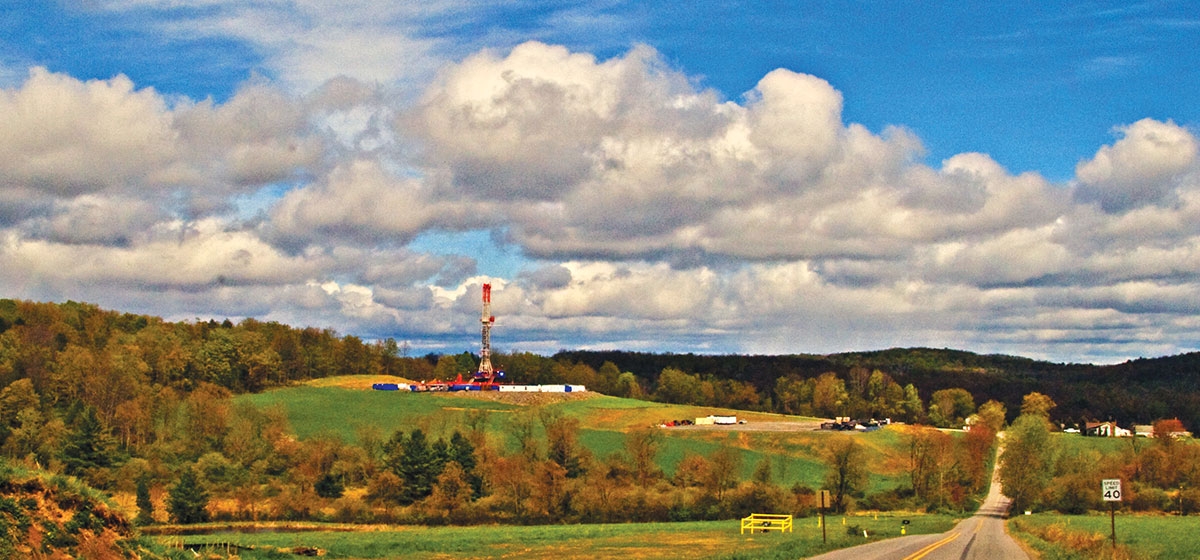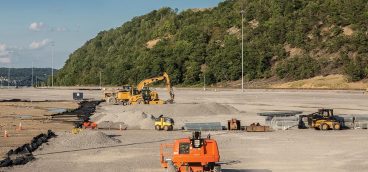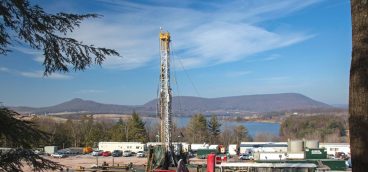A Natural-Gas Ponzi Scheme?

It was, on the surface, a devastating indictment: a report in The New York Times, the nation’s leading newspaper, alleging that the natural gas industry—an eclectic and fiercely competitive collection of players that included in its ranks everyone from cowboy drillers to staid overseas nationals like StatOil Hydro—may have joined together in a secret cabal the likes of which had not been seen in America since the days of the Standard Oil Monopoly.
Their goal, the paper seemed to insinuate, was to “intentionally, even illegally” inflate the production reports from gas wells throughout the country—from the Barnett Shale in Texas, to Louisiana’s Haynesville Shale, to the Fayetteville Shale in northern Arkansas—in an effort to lure in unsuspecting investors.
To support that allegation, the story drew heavily on a number of anonymous emails. Some of those emails have since been challenged by the companies and agencies they were leaked from. The emails embroidered the allegations with the kind of hot words that were bound to be inflammatory in a nation still recovering from the collapse of the housing bubble and accustomed to reports of corporate perfidy. “The word in the world of independents is that the shale plays are just giant Ponzi schemes,” one anonymous emailer shrieked. “These corporate guys are having an Enron moment,” an unnamed retired geologist grumbled in another.
Buried deep in the story, in the second to last paragraph, there was one glimmer of optimism. Quoting Penn State Professor Terry Engelder, the paper noted that “some wells in the Marcellus Shale, which stretches from Virginia to New York, are outperforming expectations.” The paper did not note, not then and not in a subsequent story the next day, that at the very moment that the Times was preparing its story, Cabot had announced that one of its operations in north eastern Pennsylvania had tapped into what the company called “a gusher,” producing 30 million cubic feet of natural gas a day.
A day after the Times story hit, an already jittery stock market reacted. Almost across the board, gas stocks plunged sharply. They soon recovered, but for weeks, the nagging doubts remained. Privately, and in some cases publicly, analysts and investors wondered whether the natural gas boom really is just another bubble waiting to burst.
To answer that question, it’s first essential to understand that investing in gas and even oil exploration and development has always been sort of a gambler’s game. “There aren’t a lot of people who do it because they want a guaranteed return; it’s not like bonds,” said one industry insider. There are always risks. Drillers can find that, despite their best data, they’re poking holes in a section of ground that holds too few resources to turn a significant profit, though advances in well location techniques have made that less of a problem. Conversely, they can find that they get punished for too much success; they run the risk of flooding the market and driving down prices of natural gas. As Dr. Ray Perryman, the Texas-based economist who heads the Perryman Group and has studied the economic impact of the Barnett Shale play, put it, “I don’t think it is a Ponzi scheme. Too many large firms are putting too much real money into it.”
That’s not to say shale gas is going to remain a steadily moving gravy train, he added. “The current price profile is… not conducive to high levels of development.” Still, so far, the U.S. is producing more gas than it has since 1973 and has become the world’s largest natural gas producer—in part because of the developing shale plays. This production is happening as prices have remained relatively stable in the low-to-mid-$4 range, a level at which most drillers still insist they can make a profit, at least from those wells drilled in the most productive parts of the plays. That’s especially true in the Marcellus, analysts say, where the costs of production and transportation of the gas are comparatively low, and where, because of its proximity to the nation’s largest natural gas market on the East Coast, prices are comparatively high.
It’s even more important to understand how natural gas wells produce, and how they perform over the long run. In its story, the Times echoed what has long been a minority opinion among a comparative handful of industry analysts. The contention is that, because productive shale gas wells come on strong, shooting out copious amounts of gas like champagne from an uncorked bottle, and then taper off quickly, they are inherently unprofitable. That school of thought holds that the well is a disappointment unless the drillers can recoup their costs and turn a profit almost immediately. And in tallying the production rates from a number of wells drilled throughout the two-decade-old exploitation of the nation’s shale plays, those analysts concluded that, indeed, shale wells have been disappointing. Many of the wells included, however, were vertical wells drilled before geologists and engineers honed their skills at picking the sweet spots of the shales, and before advances in drilling and hydrofracking boosted production numbers for newer wells.
The industry and a majority of analysts take a far different view. As Mark Whitley, an original pioneer of shale gas expansion and now senior vice president in charge of Range Resources southwestern and northern Appalachian operations, put it, the critics are using the wrong yardstick to measure the value of the nation’s shale plays.
First of all, he argues, not all portions of any given stretch of shale are created equal. Some areas are just richer than others. “When you look at all the plays in the United States—in the world for that matter—all resources are distributed by Mother Nature. That applies whether it’s oil and gas, or coal, or gold or iron. If you look at mines, there are really high-yielding mines, and there are mines that are very poor-yielding.”
The trick, he said, is learning where the sweet spots are. In the Barnett Shale, for example, which underlies about 30 million acres of Texas, roughly 10 percent—about 3 million acres—is categorized as the “core” part of the play. The core is where the shale is at just the right depth, just the right thickness, and under enough pressure to optimize gas production. As you move further away from the core, the wells gradually become less promising. It took years, and many less-than-stellar wells, for drillers to clearly identify the core of the Barnett, Whitley said. “We’ve got something around 15,000 wells… a lot… drilled in the fringe areas of the play that are not considered to be part of the core today. If you look at those as a subset, you say, ‘Aha! It doesn’t work.’ Well, it didn’t work at the time… the shale was too thin, too shallow, too under-pressured. Geology worked against you. We discovered that over several years.”
By the middle of the last decade, however, drillers had honed their understanding of how to find the sweet spots in the Barnett. They had also improved two critical technologies to exploit those sweet spots: horizontal drilling and “slick water fracking,” the process by which chemically treated water is blasted into the buried rock to shatter it and release the gas. And the Barnett became the most productive gas field in America. It had taken more than 15 years. According to a 2009 study conducted by analysts at the Ross Smith Energy group, wells drilled in the Barnett core were twice as productive as those drilled outside the sweet spot, and wells drilled using the modern techniques of horizontal drilling and improved hydraulic fracturing were 2Q times more productive on average than the older vertical wells.
The lessons learned in the Barnett were soon applied elsewhere, allowing drillers to zero in more quickly on the richest deposits. When the Haynesville play opened up in Louisiana, drillers quickly identified the 12 percent of it that could be considered prime real estate, and within three years, it had supplanted the Barnett as the nation’s richest play.
Here in Pennsylvania, where even critics concede the shale has exceeded expectations, the lessons learned elsewhere have again been applied. Drillers and geologists have concluded that the 60 million-acre Marcellus Shale includes more than one “core” area, encompassing what drillers and many geologists believe is significantly more than 10 percent of the total. Within the boundaries of the Commonwealth of Pennsylvania alone, geologists believe there are two cores, one in the southwestern part of the state, which produces gas heavy with valuable liquids such as butane and pentane. The other is in the northeastern part of the state, where the gas is dry enough to be almost market-ready. And as Engelder is quoted as saying in the Times, production in Pennsylvania has indeed exceeded expectations.
In early 2010, for example, the Marcellus Shale Coalition commissioned a study by Penn State researchers to estimate production for the year. “They produced a report in the spring… and it projected over 1,700 wells would be drilled, and there would be a billion cubic feet per day equivalent of gas,” said Coalition president Kathryn Klaber. When they reviewed the actual results at the end of the year, they discovered that the Marcellus had been more than twice as productive as they had anticipated. “There were 300 fewer wells drilled in Pennsylvania, about 1,450 instead of more than 1,700,” she said. But together, those wells produced “about 2 billion cubic feet per day equivalent by the end of the year.”
Currently, the industry estimates that it is churning out about 3 billion cubic feet a day out of the Marcellus, with much of the activity focused in the two richest areas, in the southwest and northeast.
Of course, the prodigious production of gas that erupts when a gas well is first drilled is not sustainable. Shale gas wells, like all gas wells, are pressure driven. The highly pressurized gas is forced to the surface by its own mass. As the pressure is relieved, the rate of flow decreases, often dramatically, in the first year or two of production. “Depletion drive” is the phrase the industry uses to describe the process. Those steep drops in production numbers have led some critics, like those cited by the Times, to speculate that the wells, even the new ones, drilled in the sweet spots of the shale and completed with state-of-the-art techniques, will quickly peter out, making them inherently unprofitable in the long run.
But the industry begs to differ. Gas industry executives maintain that the initial production rates, as welcome as they are, are only part of the picture. To be sure, Whitley said, the nature of gas wells is such that companies expect to make their investment back in the first few years after a well comes on line. “The payout period usually occurs within those first two to four years. That’s when we make our money back.” In the Marcellus, he said, drillers have generally made their stake back within the first two years. But the profit comes later, over the long haul. And he dismisses the suggestion that those profits will simply plunge back down into the holes they came out of.
“The comment that these wells just peter out, that’s not the case,” said Whitley. “They don’t peter out. They do decline, that’s the nature of the production mechanism.” But that hyperbolic decline, as it’s called, levels off. In its 2009 study, Ross Smith Energy, for example, estimated that the average Barnett well declined at a rate of about 5 percent a year after the steep decline of the first two years or so.
In the Marcellus, which geologist Engelder has estimated to hold nearly 500 trillion cubic feet of recoverable natural gas, the industry estimates that, after the initial plunge, the long-term rate of decline will be about 10 percent after five years and 3 to 5 percent a year for the rest of the life of the well.
The question then becomes, how long is the life of a well? And that remains an open question. For its part, the industry maintains that the wells drilled in the Barnett, the Haynesville, the Fayetteville, and especially the Marcellus Shale have long and productive lives ahead. In an internal memo to his employees a few days after the Times story was published, Chesapeake Energy CEO Aubrey McClendon wrote, “we know that the initial productivity associated with a majority of our shale gas wells have been steadily improving over the years in all of our gas shale plays, both in initial production rates and the expected ultimate recovery of natural gas…. We fully expect that the majority of these wells will be productive for 30 to 50 years and even longer.”





